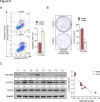Elevated FAM134B expression induces radiation-sensitive in hepatocellular carcinoma
- PMID: 37460952
- PMCID: PMC10353116
- DOI: 10.1186/s12885-023-11030-x
Elevated FAM134B expression induces radiation-sensitive in hepatocellular carcinoma
Abstract
Background: Previous studies have shown that Family with sequence similarity 134 member B (FAM134B) was involved in the occurrence and development of malignancy, however, the function and molecular mechanism of FAM134B in Hepatocellular Carcinoma (HCC) radiotherapy resistance remain unclear. Therefore, it may clinical effective to clarify the molecular mechanism and identify novel biomarker to overcome radiotherapy resistance in HCC.
Methods: The protein and mRNA expression of FAM134B were determined using Real-time PCR and Western blot, respectively. IHC assay was performed to investigate the association between FAM134B expression and the clinicopathological characteristics of 132 HCC patients. Functional assays, such as in situ model, colon formation, FACS, and Tunel assay were used to determine the oncogenic role of FAM134B in human HCC progression. Furthermore, western blotting and luciferase assay were used to determine the mechanism of FAM134B promotes radiation-sensitive in HCC cells.
Results: We noted that FAM134B was downregulated in HCC, which was correlated with the radiation resistance in patients with HCC. Overexpression of FAM134B contribute to radiation sensitive in HCC; however, inhibition of FAM134B confers HCC cell lines to radiation resistance both in vitro and in vivo. Moreover, we found that FAM134B interacts with FMS related receptor tyrosine kinase 3 (FLT3) and downregulation of FAM134B activated JAK/Stat3 signaling pathway. Importantly, pharmacological inhibition of JAK/Stat3 signaling pathway significantly counteracted downregulation of FAM134B-induced radiation resistance and enhanced radiation therapeutic efficacy in HCC.
Conclusions: Our findings suggest that FAM134B may be a potential therapeutic biomarker for the treatment of HCC patients with radiotherapy tolerance.
Keywords: FAM134B; FLT3; HCC; JAK/Stat3 signaling pathway; Radiotherapy-resistance.
© 2023. The Author(s).
Conflict of interest statement
The authors declare no competing interests.
Figures






References
-
- Wahl DR, Stenmark MH, Tao Y, Pollom EL, Caoili EM, Lawrence TS, Schipper MJ, Feng M. Outcomes after stereotactic body radiotherapy or Radiofrequency ablation for Hepatocellular Carcinoma. J Clin oncology: official J Am Soc Clin Oncol. 2016;34(5):452–9. doi: 10.1200/JCO.2015.61.4925. - DOI - PMC - PubMed
MeSH terms
Substances
Grants and funding
- No.81760496/Natural Science Foundation of China
- No. 81974443/Natural Science Foundation of China
- 20202BAB206040/Natural Science Foundation of Jiangxi Province
- YJZD202001/Project of the First Affiliated Hospital of Gannan Medical University
- YJYB202103/Project of the First Affiliated Hospital of Gannan Medical University
- YJYB202102/Project of the First Affiliated Hospital of Gannan Medical University
- 20212BAB216067/Youth Science Foundation of Jiangxi Province
- GJJ211510/the Science and technology research project of the Education Department of Jiangxi Province
- N0. GJJ 170878/the Science and technology research project of the Education Department of Jiangxi Province
- 2017A030313547/Natural Science Foundation of Guangdong Province
LinkOut - more resources
Full Text Sources
Medical
Molecular Biology Databases
Miscellaneous

